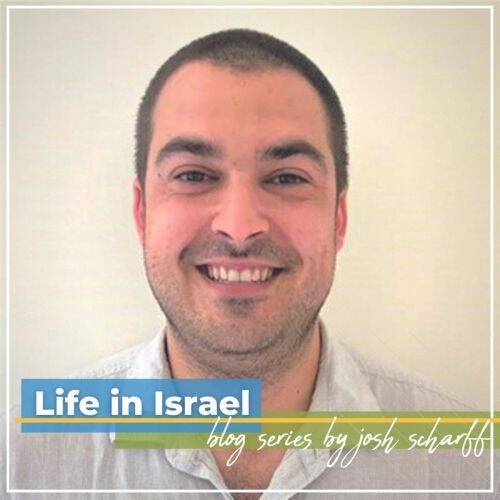A 4-PART BLOG SERIES ABOUT LIFE IN ISRAEL
08/19/2022 01:37:18 PM
WEEK #3: August 19, 2022
 Hello! Thanks for tuning back in to this week’s entry in “Reform Judaism in Israel.” In last week’s blog, I touched on some of the historical and societal developments that kept liberal Judaism, meaning the non-Orthodox streams, from becoming the dominant stream as it has in North America. While it is true that Reform Judaism is still much smaller in Israel when compared to the Orthodox streams, the last two decades have seen incredible growth in the number of congregations, the number of ordained Israeli rabbis, and, most significantly, the number of Israelis who openly define themselves as Reform Jews.
Hello! Thanks for tuning back in to this week’s entry in “Reform Judaism in Israel.” In last week’s blog, I touched on some of the historical and societal developments that kept liberal Judaism, meaning the non-Orthodox streams, from becoming the dominant stream as it has in North America. While it is true that Reform Judaism is still much smaller in Israel when compared to the Orthodox streams, the last two decades have seen incredible growth in the number of congregations, the number of ordained Israeli rabbis, and, most significantly, the number of Israelis who openly define themselves as Reform Jews.
The success of the last decade should not be overlooked. There have been hundreds, if not thousands, of laypeople and clergy who have worked tirelessly to strengthen the presence of liberal Judaism in Israel. In every meaningful way we can see the significant and sustained growth of liberal Judaism. Cities and municipalities in which, if you had suggested twenty years ago that there was a chance to found a functioning Reform community here you would have been laughed out of the room, now boast functioning and self-sustaining congregations. The amount of creativity and creation in liberal Judaism is tremendous: a new Israeli Reform prayer book, publications on Judaism from a Reform perspective, music made specifically for a Reform setting, just to name a few. There is a growing youth group (similar to our TIFTY) that is organized around the synagogues and meets with the other branches spread throughout the country. When the history of the Israeli Reform movement is written, these past two decades will be viewed as a major inflection point. I, personally, have a great deal of respect for those who have worked so hard to bring us to where we are today as a movement.
This growth has not come without challenges, large and small. I want to present in this entry two types of challenges that liberal Judaism has had and will continue to struggle with in coming years.
The first challenge is the growing, open opposition to non-Orthodox practice in Israel amongst the Orthodox. In this context when I use the term Orthodox I am referring to both modern-Orthodox as well as ultra-Orthodox, though the opposition of the latter is stronger and more visible than the former. It can be seen in many place: Orthodox representatives in the Knesset who refer to Reform Jews as ‘pigs’ or ‘Christians’, the large number of young Orthodox men and women brought to the Kotel each Rosh Chodesh (beginning of a new Jewish month) to drown out the prayers of Women of the Wall (an organization fighting for pluralism and equality at the Western Wall), the use of ‘Reform Jew’ as an insult for anyone challenging the narrow method of Orthodox practice to mark him or her as less Jewish. There is near uniform opposition from Orthodox spaces to the spread of egalitarian, non-Orthodox Judaism. Because of ultra-Orthodox presence in Israel’s governments from the 1990s until the immediate past government, state institutions have also been partners in the fight to keep the Reform and Conservative unequal in their influence. For example, up until 2021, Reform conversions completed here in Israel were not recognized by the Interior Ministry for the purposes of making Aliyah. Think about that, a person who completed a Jewish conversion in Israel, was not able to receive the same rights to citizenship that I was afforded as a Jew who grew up in North America. This has forced the liberal Jewish streams to turn to the courts in Israel to challenge this set of practices. While the courts have been reluctant to get involved in matters of synagogue in state, the law is with us and we have won a great deal of meaningful court decisions, including the aforementioned 2021 case.
This external political and cultural opposition to Reform Judaism will likely only be strengthened, paradoxically, as liberal Judaism continues to carve out a foothold in Israeli society. The larger the “threat” of non-Orthodox Judaism becomes, as an alternative to Orthodox Judaism becomes more viable, the harder Orthodox and its leaders will fight to maintain their monopoly over Israeli Judaism. Since this challenge comes from external sources, only some of it is within our control and we will continue to struggle to ensure full rights for non-Orthodox Jews according to the laws of Israel. The second challenge is one over which we have much more control.
The second challenge we face is what I would summarize as the general apathy towards Jewish tradition and practice in the secular Israeli population. In Israel, Reform Judaism must convince people who live their lives in the Jewish language, celebrating Jewish holidays, and living according to Jewish time that there is added value and meaning to participation in organized Judaism. For years, committedly secular Israelis were not interested in liberal Judaism. Yet in the last 30 years we have seen a growth in the number of Israelis who are seeking a Judaism that matches the secular values by which they live their life: egalitarianism, liberalism, equality. Typically, people find Reform Judaism for a one-off life cycle event and end up staying involved in the community when they experience a manner in which to practice Judaism that was previously unknown to them. We have a long way to go and many more Israelis to convince, but the signs are there that we are slowly but surely winning this struggle for hearts and minds.
I hope I was able to make a bit clearer two of the many challenges that Reform Judaism faces in Israel. There are of course many more, alongside many signs of hope and progress. Next week, I will discuss how you and Jewish communities in the States can be involved to help us move our essential work in Israel forward! In the meantime, I welcome you to be in touch at joshua.scharff@gmail.com.



